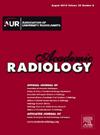改进的CT波束硬化降低——对急诊脑成像图像质量和诊断确定性的影响。
IF 3.9
2区 医学
Q1 RADIOLOGY, NUCLEAR MEDICINE & MEDICAL IMAGING
引用次数: 0
摘要
基本原理和目的:评估优化的波束硬化伪影减少算法对急诊非增强脑CT图像质量和诊断确定性的影响。材料与方法:对2023年连续行非增强脑CT排除外伤性脑损伤患者进行回顾性研究。使用(A)标准和(B)优化的迭代波束硬化校正算法(iBHC)重建图像。测量脑桥、幕上、幕下皮层CT衰减、图像噪声和信噪比。计算后颅窝伪迹指数(PFAI)和颅下伪迹指数(SAI)。两名神经放射科医生和两名急诊放射科医生使用5点李克特量表和并排比较,独立比较了两种算法之间的伪像和诊断确定性。采用配对wilcoxon检验并校正多重检验。结果:连续100例患者(女性55例;(64.1±20岁)。结论:优化后的iBHC算法显著改善了图像质量,减少了伪影,提高了急诊非增强脑CT的诊断确定性。本文章由计算机程序翻译,如有差异,请以英文原文为准。
Improved Beam-hardening Reduction in CT - Impact on Image Quality and Diagnostic Certainty in Emergency Imaging of the Brain
Rationale and Objectives
To assess the impact of an optimized beam-hardening artifact reduction algorithm on image quality and diagnostic certainty in emergency unenhanced brain CT.
Materials and Methods
Retrospective study of consecutive patients referred for unenhanced brain CT to rule out traumatic brain injuries in 2023. Images were reconstructed using both (A) a standard and (B) an optimized iterative beam-hardening correction algorithm (iBHC). CT attenuation, image noise and SNR were measured in the cortex of supratentorial and infratentorial regions and in the pons. Posterior Fossa Artifact Index (PFAI) and Subcalvarial Artifact Index (SAI) were calculated. Two neuroradiologists and two emergency radiologists independently compared artifacts and diagnostic certainty between both algorithms using 5-point Likert scales and side-by-side comparisons. A paired Wilcoxon-test with correction for multiple testing was used.
Results
100 consecutive patients (55 women; 64.1 ± 20 years) were included. CT attenuation was significantly lower for B (all P <.0001). SNR was significantly lower supratentorial (frontal region: 10.5 vs. 12.9, P<.0001) and significantly higher in the pons (5.9 vs. 5.5, P <.0001) for B. PFAI was significantly reduced for B (5.5 vs. 6.4, P <.0001), while there was no significant difference in SAI (P = 0.304). The optimized algorithm was selected as superior in 100%, 100%, 99%, 99% of supratentorial and in 100%, 99%, 99%, 86% of infratentorial cases for readers 1 to 4, respectively.
Conclusion
An optimized iBHC algorithm demonstrated significantly improved image quality, reduced artifacts and improved diagnostic certainty in emergency unenhanced brain CT.
求助全文
通过发布文献求助,成功后即可免费获取论文全文。
去求助
来源期刊

Academic Radiology
医学-核医学
CiteScore
7.60
自引率
10.40%
发文量
432
审稿时长
18 days
期刊介绍:
Academic Radiology publishes original reports of clinical and laboratory investigations in diagnostic imaging, the diagnostic use of radioactive isotopes, computed tomography, positron emission tomography, magnetic resonance imaging, ultrasound, digital subtraction angiography, image-guided interventions and related techniques. It also includes brief technical reports describing original observations, techniques, and instrumental developments; state-of-the-art reports on clinical issues, new technology and other topics of current medical importance; meta-analyses; scientific studies and opinions on radiologic education; and letters to the Editor.
 求助内容:
求助内容: 应助结果提醒方式:
应助结果提醒方式:


